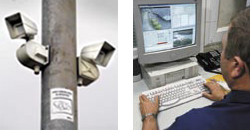Network Security stamps out vandalism in Newport Schools
Mission
Newport City Council schools needed to find a way of reducing vandalism that had become a common problem for many more schools across the region.
Solution
The Newport Community Safety Partnership initiative, created a fully networked surveillance solution, which enabled monitoring of hotspots after hours.
AXIS 2400 Video Servers were deployed to distribute video from CCTV cameras onto the network. The entire solution enabled alarm activation and relaying of video footage to a central monitoring centre in the council's civic centre on a 24 hour, 7 days-a-week basis.
Result
Considerable cost savings have already been achieved. All incidences of vandalism within the pilot site and damage to property have been stopped in their tracks, saving the council over £6,000 per year. Video footage transmitted to the central monitoring centre has clearly identified individuals involved in unauthorised access, vandalism and antisocial behaviour. This solution used excess bandwidth capacity out of school hours to provide the network at no extra cost.
Customer
"Having the right infrastructure in place is vital for development of innovative solutions. The combined solution should save the council over £75,000 per year." - Phil Cox, Principal Consultant, Newport Council
Vandalism was costing South Wales schools tens of thousands of pounds
Newport City Council in South Wales was suffering from a number of security issues with its local schools. Generally, school premises are regarded as a community resource, so that local people can make best uses of the facilities in a safe environment.
 Sadly some youngsters had been running amok on the flat roofs of some school buildings, lighting fires and engaging in other anti-social and dangerous activities. One school faced a £14,000 bill per year for replacement glazing alone. The council had been paying out hundreds of thousands of pounds each year to fix all the damage being caused across all schools. The council recognised that it needed to put together a plan to stem this rising tide of vandalism.
Sadly some youngsters had been running amok on the flat roofs of some school buildings, lighting fires and engaging in other anti-social and dangerous activities. One school faced a £14,000 bill per year for replacement glazing alone. The council had been paying out hundreds of thousands of pounds each year to fix all the damage being caused across all schools. The council recognised that it needed to put together a plan to stem this rising tide of vandalism.
Advanced digital CCTV solution
The Newport Community Safety Partnership, which combined the City Council and Gwent Police, brought together private sector partners including NTL, Axis Communications, Farsight and Bewator (Molynx) to develop a solution using advanced digital CCTV technology.
Live video footage was fed from an average of four cameras in each of the six schools in the initial phase, via AXIS 2400 Video Servers via the network to the central monitoring centre. When people approach the area, PIR detectors that are trained on sensitive areas of the school, such as the approaches to flat roofs and identified hot spots, detect the movement and trigger alarms that are passed back to the monitoring centre.
Operators using special eSurveillance software can then take full control of the cameras and monitor and record the footage. Additionally, images could be securely viewed via an Internet browser over the Wide Area Network (WAN) by authorized staff from selected desktops.
Simple installation
Investment in the solution was dramatically reduced by the fact that no additional infrastructure was needed. These schools have all invested in Newport's National Grid for Learning (NGfL) scheme which provides a local network environment with a number of PCs with high-bandwidth lines connecting directly back to the corporate hub-and then to the Internet.
In addition no dedicated CCTV infrastructure such as expensive coaxial twisted pair cabling was needed to link back to the monitoring station. Implementation was simply a matter of the local CCTV installation connecting to the Axis video server, which is then plugged up directly to the computer network; an IP address was then assigned to it, so that the civic centre's remote monitoring centre staff could dial in to remotely monitor the schools.
IP-Surveillance ideal for schools
The National Grid for Learning provides a great opportunity for schools to tighten up their security and reduce vandalism to property. The fact that the majority of schools in the United Kingdom are now networked and have some PCs linked up to the Internet by virtue of Government investment over recent years, makes it possible to use this infrastructure to implement networked IP-Surveillance solutions.
 Once networked it is possible to easily transfer and save high quality, live video providing the sort of flexibility that is ideal for schools which may want to hand over 24 hour surveillance to a third party. The fact that, in this instance, most of the damage was being done after hours when pupils have mostly gone home and are unlikely to be using the computer facilities makes use of networked IP surveillance even more compelling.
Once networked it is possible to easily transfer and save high quality, live video providing the sort of flexibility that is ideal for schools which may want to hand over 24 hour surveillance to a third party. The fact that, in this instance, most of the damage was being done after hours when pupils have mostly gone home and are unlikely to be using the computer facilities makes use of networked IP surveillance even more compelling.
New applications for the surveillance system are already being explored - it now helps teachers and cleaning staff working late, to feel safer by alerting central control that they are about to leave for home so that they can be ‘escorted' out to their cars, and actively supports the keyholder and response services when entering the site following a callout.












